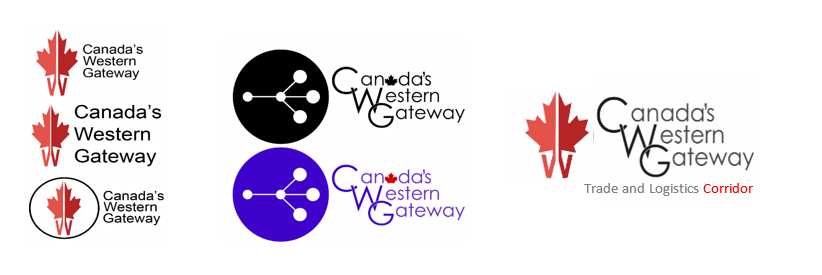
Southern Alberta’s Highway 4 corridor is a key contributor to the regional, provincial and national economy. Anchored by the Coutts/Sweetgrass border crossing on the south and the Lethbridge Airport on the north, the region houses more than 200 businesses and more than 3,000 employees. Now, Canada’s Western Gateway Trade and Logistics Corridor is bringing together stakeholders to work together and advocate for the region’s best interests.
One step in this process is building a visual identity. For this stage, the group turned to Lethbridge College’s Digital Communications and Media (DCM) program. Students were given the opportunity to create a logo and pitch their designs to the stakeholders as part of a competitive process. Canada’s Western Gateway chose elements of designs from two students, Cole Cyre and Colton Won, and the organization will work with the students to create the final product.
“We are extremely pleased at the successful result of the collaboration between Canada’s Western Gateway and the design students at Lethbridge College in creating our new logo,” says Martin Ebel, Economic Development Officer, Lethbridge County. “It provides strong visual representation of what Canada’s Western Gateway will be – a trade and transportation corridor that will support and enhance the economic opportunities in southern Alberta.”
Students were provided with an action brief and a copy of Canada’s Western Gateway’s strategic plan, and then tasked with creating a logo and visual identity that helps identify the organization.
“We would like to thank the Lethbridge College Digital Graphics class, led by Martina Emard, for all the work that they did on the logo for Canada’s Western Gateway Trade and Logistics Corridor,” says Mayor Peggy Losey, Town of Milk River. “The thoughtful work by the students was very well done. Bravo to all the students involved. Canada’s Western Gateway is an exciting venture that will provide economic opportunities to all our communities along the corridor.”
The process of designing a logo and presenting it to the organization matched the circumstances students will face once they begin their careers. Exposing students to work-integrated learning opportunities is immensely beneficial to their learning and readiness for the workforce.
“This isn’t the first time we’ve collaborated with local non-profit organizations to create marketing materials,” says Martina Emard, DCM instructor, Lethbridge College. “We’re very fortunate that the Canada’s Western Gateway group reached out to us with the challenge to create the logo. Not only do the students get to experience interpreting the organization’s vision into a visual identity, they learn how to effectively pitch and defend their decisions to a client.”

Won’s logo features a maple leaf that opens in the middle like a gateway and comes to a “W” point at the base of the stem. Canada’s Western Gateway chose to blend Won’s logo with Cyre’s wordmark, which features an interlocking C, W and G.
“I realized I needed to think about this logo design more abstractly,” says Won, a second-year student from Lethbridge. “The emphasis placed on Canada was the inspiration that led to my shift in focus to create a more symbolic design that not only reflected Canada, but also a metaphorical interpretation of the Western Gateway project. Overall, I think this experience has been a good opportunity to help me grow as a designer and has taught me that, like anything else in life, you just have to keep trying until you get it right.”
Won and Cyre were awarded prizes for their designs, while all the students in the class received gift cards for their participation. Won and Cyre will be involved in the process of finalizing the logo.

“I spent a lot of time and energy on the icon portion of my logo, so much that when I finished I realized the typeface needed to have some attention as well, and I am glad I did,” says Cyre, a second-year student from Lethbridge. “I plan to have my own filmmaking business, based in southern Alberta, with a focus on exacting real change in my home province, and hopefully home country. This will help with my future career because I was able to show how my expertise helped a project like Canada’s Western Gateway exact positive change in my province, which in turn proves that I am serious about my mission.”
Canada’s Western Gateway has eight key stakeholders and more than 20 potential partners. The corridor is essential for moving goods through road, rail and air transportation, and it also is home to warehouses, storage areas, distribution centers, offices, trucking and other shipping services.
“As we see growing interest in this region’s bountiful agricultural capacity and renewable energy development potential, as well as growth in traditional economic sectors, the region’s ability to process, store and ship both outgoing and ingoing goods will be a key strategic component for long term success,” says Ebel. “Canada’s Western Gateway is a proactive step in ensuring the region’s economic potential is not constrained by logistical hurdles in the decades to come.”
Canada’s Western Gateway Trade and Logistics Corridor will develop and promote a robust regional, sustainable supply chain and logistics ecosystem by building capability, investing in critical infrastructure, proactively eliminating barriers to business and being investment ready.
Lethbridge College’s DCM program prepares students for success in any media environment, teaching skills in journalism, corporate communications, radio, video, photography and graphic production to recognize industry needs.